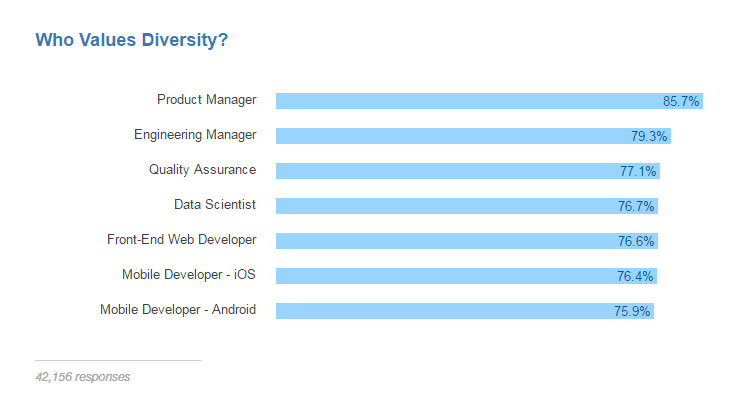10 steps to hire more women in tech

As Sundar Pichai, Google’s CEO says, “A diverse mix of voices leads to better discussions, decisions, and outcomes for everyone.” That’s especially significant in tech companies who aim to drive innovation. That said, women in tech remain underrepresented both in startups, SMEs, and corporations globally. In this post, we will present the 10 steps you need to take to hire more women in tech.
It’s common knowledge that the world of software engineering is a predominantly male environment. Diversity reports from tech leaders like Google, Slack, Pinterest, and Uber show that women in tech are greatly outnumbered. Slack tops the list with 29.8% of women in technical roles, which is significantly greater than the results of its peers:
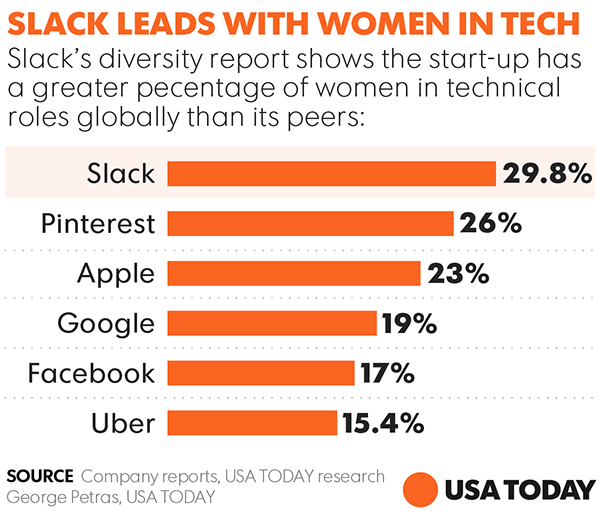 Source: USA TODAY
Source: USA TODAY
Gender diversity is a significant and positive predictor of productivity and hiring more women in tech is one of the main ways to diversify the tech workforce. As Jessica Guynn of USA TODAY points out, Slack wanted to avoid,
growing the way technology companies typically do by hiring a lot of white and Asian men. One of the executives penned a manifesto that pledged Slack would hire as many people from diverse experiences and backgrounds as it could.
This proves even companies who focus on diversity early on and make a conscious effort to diversify struggle to do so.
The way Slack reached the top of the “women in tech” list is with a conscious, pre-planned effort.
And that’s exactly the way you need to go about it. To hop you out, this post will cover,
- Women in tech: benefits
- Do developers want gender diversity?
- Female developers in numbers
- 10 ways to welcome women in tech to your tech team
Women in tech: benefits
- MONEY: A 2015 McKinsey “Why diversity matters” report analyzing 366 public companies found that “those in the top quartile for gender diversity were 15% more likely to have returns above the industry mean”,
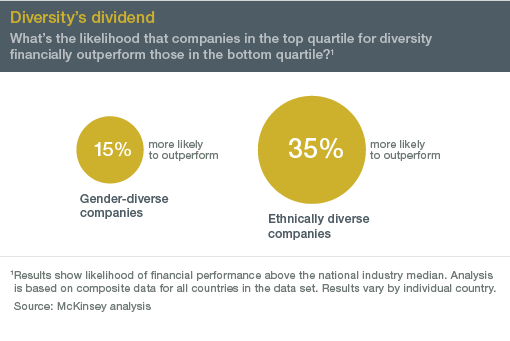
Source: McKinsey
- PRODUCTIVITY: A Massachusetts Institute of Technology and George Washington University study reveals that employees tend to be happier when they work with people of the same gender, but are generally more productive when they work in a nonhomogeneous environment.
- CREATIVITY: Nonhomogenous teams stimulate the brain because they tend to challenge stale ways of thinking. Due to what the psychologists call fluency heuristic, humans tend to favor information that can be processed easily or they already know, which they believe to be true or more beautiful (that’s why certain songs or slogans grow on you after you hear them a couple of times). When you step out of what you already know, you’re most likely to achieve growth.
- EVEN MORE MONEY: According to 2014 Credit Suisse analysis “large-cap companies with at least one woman on the board have outperformed their peer group with no women on the-board by 26% over the last six years.”
Of course, correlation doesn’t equal causation, so you can’t just hire any woman who applies and expect to achieve growth – you still need to monitor QoH (Quality of Hire). “Greater gender and ethnic diversity in corporate leadership doesn’t automatically translate into more profit), the correlation does indicate that when companies commit themselves to diverse leadership, they are more successful.” One of the reasons is that women in tech are probably more drawn to diverse teams where they get work with both male and female colleagues.
Do developers want gender diversity?
In the 2016 Developer Landscape survey by Stack Overflow, 73% of developers said gender diversity was “at least somewhat important in the workplace” and 41% of them said it was very important. Software engineers who influence hiring decisions were most likely to believe in the importance of diversity in comparison to other developers.
Source: Stack Overflow
Female developers in numbers
- According to PayScale, men dominate at all levels in the Tech Industry. If you look at their data, you can see that the number of women occupying each of the positions listed below is much lower than those outside of the industry. Tech still has loads of room for improvement and hard as we try, it’s still a boys’ club.
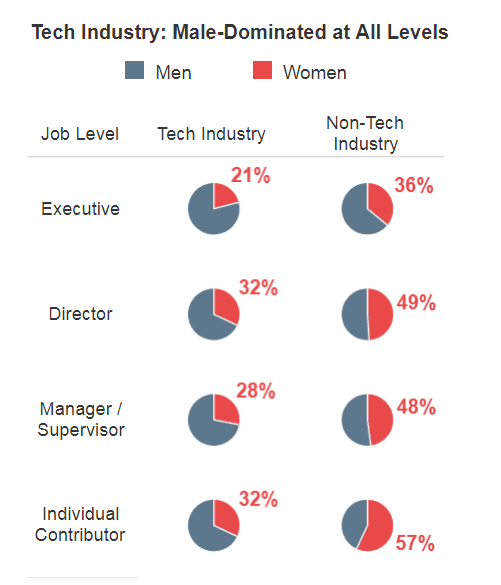 Source: PayScale
Source: PayScale
- Results of the 2016 Developer Landscape survey by Stack Overflow show just how male the software development world is, with a staggering 92.8% of survey participants identifying as men.
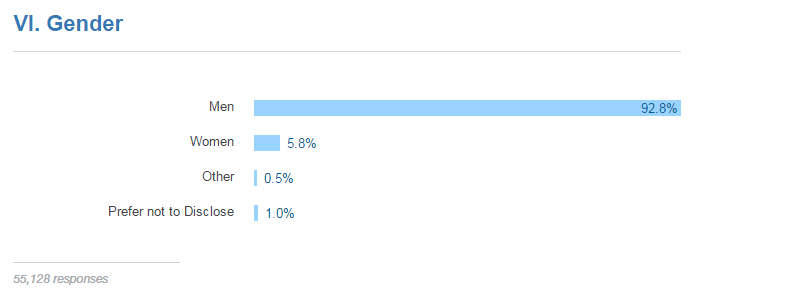
Source: Stack Overflow
However, this statistic underrepresents women in tech and Stack Overflow staff say their internal data suggests the imbalance isn’t as severe. However, in the majority of “programming teams, men outnumber women often by significant margin”.
- Industry leader Slack has the most women in tech positions (29.8%). Women constitute 43.5% of their overall workforce worldwide,
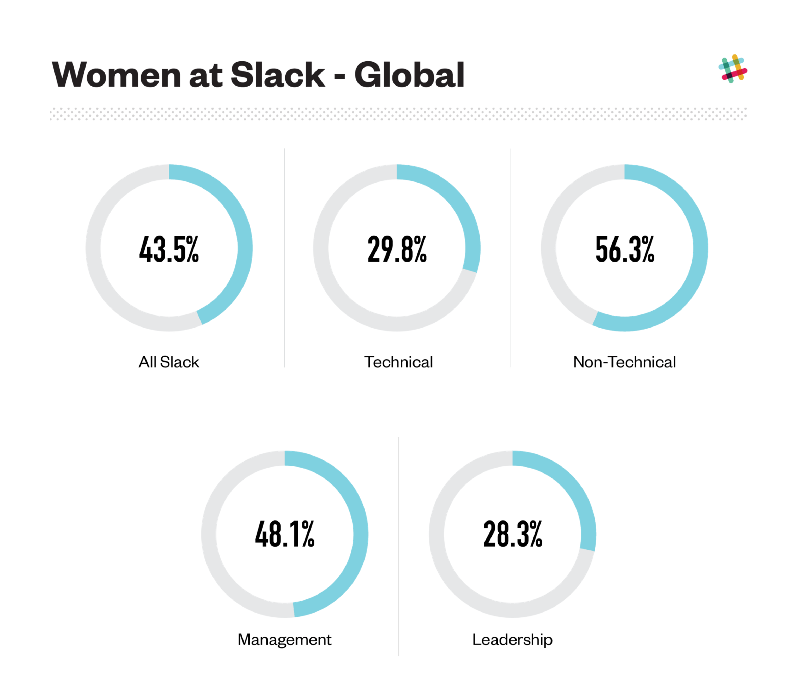
- David Smith ran an analysis based on the original study based on Face API by Jeff Allen from Trestle Tech and found that most GitHub contributions from female members were found in the “R” category, with almost 10% of contributors to R projects being female,
 Source: Revolutions
Source: Revolutions
- According to the authors of Gender Differences and Bias in Open Source: Pull Request Acceptance of Women Versus Men gender bias pervades open source. The study looked at acceptance rates of contributions from male and female members in an open source software community and yielded interesting results:
1) women’s contributions tend to be accepted more often than men’s,
2) women’s acceptance rates are higher only when they are not identifiable as women.”
The results suggest that despite being more competent overall, women on GitHub are subject to a strong bias.
10 ways to welcome women in tech to your tech team
 Image source: ART+marketing
Image source: ART+marketing
As a tech recruiter, your job is to fill positions quickly and efficiently. Sadly, issues like diversity are often deemed less important than metrics such as speed of hire.
In order to hire diversely, you need to look at your team as a whole. Jeanette Stock of Pressly and Venture Out has an excellent point:
hiring the best person and hiring the best team which studies show is a diverse team is not necessary always opposite. You’re not hiring in isolation. Building a team is like taking raw blocks and trying to put them together in a way that makes the strongest structure, and if you have all the blocks that are leaning one way that you just stack on top of each other, eventually that tower is going to fall over.
If the team you’re hiring for is predominantly male (so all the blocks lean one way, as Stock would say) but you want to bring change to your structure, here are the 10 steps you need to take to attract women in tech.
1. Run mandatory unconscious bias training
It’s taken by all new hires during orientation at Google and Google is right to do so. It’s time you followed suit.
2. Review your job postings for unconscious gender bias
There are some pretty ugly examples of gender bias, like this one Ella Gorev of Nulogy came across:
 …and this one when developer Leigha Mitchell criticized a sexist recruiter post:
…and this one when developer Leigha Mitchell criticized a sexist recruiter post:
 3. Work on your Careers page
3. Work on your Careers page
It’s one of the first places people go to work out what kind of an employee you are. As Leigha Mitchell says, “if it’s plastered with pictures of white guys in flannel with beards, that’s a red flag.” Mitchell says if that’s the case, the page should include a statement explaining that you want to diversify and why you want to do it. She adds that another frequently used trick she’s seen is including an outline of a female silhouette with a caption “This could be you!”.
Mitchell also recommends involving women in the interview process, especially when talking to female candidates. This makes them more at ease when it comes to asking certain questions which can only be answered by other women in tech. She suggests that if there are no women on the team you’re recruiting for, it’s a good idea to “bring someone from another team for a culture interview”.
4. Bridge the gender pay gap
According to PayScale, gender pay gap in tech is lower than that of non-tech industry. However, there’s still a lot of work to be done. As you can see, the gender pay gap gets bigger as people move into more senior roles.
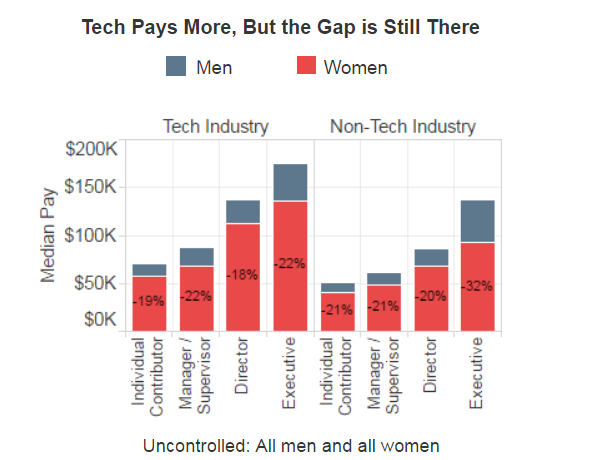
Source: PayScale
Here’s the data when you consider pay of similar men and women in similar jobs:
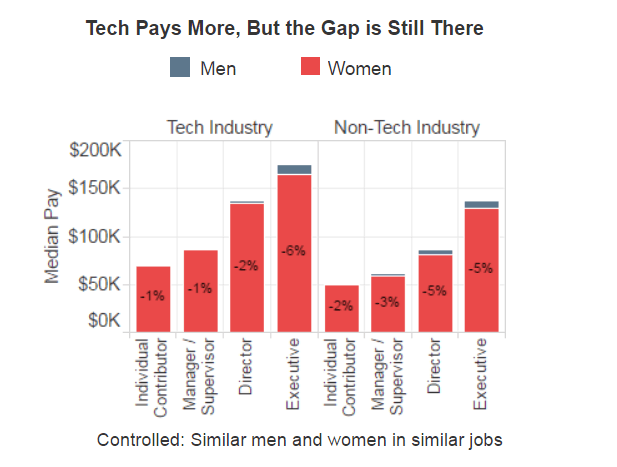
Source: PayScale
The gender pay gap gets bigger as people move into more senior roles in this group, too.
For example, the gap for similar men and women in similar jobs in the tech industry goes from -1% for Individual Contributors to -6% for Executives. Male Median Pay for Individual Contributors is $70,900 and Female Median Pay for the same job equals $70,000. For executive jobs in tech, Male Median Pay and Female Median Pay equal $174,600 and $164,800 respectively.
5. Consider salary transparency
As Molly Koernke says, “salary transparency evens the playing field for women”.
6. Don’t penalize women for negotiating pay
A Harvard University study “Social incentives for gender differences in the propensity to initiate negotiations: Sometimes it does hurt to ask” shows that women get penalized more than men when initiating salary negotiations, even by female evaluators “assessing willingness to work with a candidate from written transcripts”. Keep that in mind next time someone tries to negotiate pay and devise a comfortable environment for discussing salaries and policies.
7. Give a small (and friendly) nudge
At Google, engineers typically nominate themselves for promotion, but the company found they wouldn’t do that as often as their male colleagues (even when they clearly should have). Alan Eustace, one of the heads of engineering at that point, sent an email describing these two studies:
– When answering math problems, girls tend to raise their hands less frequently than boys, even though they are more accurate in their answers when they finally decide to speak.
– Women are more reluctant than men to offer their ideas in business meetings even though they are often better than many offered by their male colleagues (as evaluated by observers).
Eustace followed them with a statement that it was time for to apply for promotions, and as you can expect, the application rate of female engineers soared. He sent the email a number of times and it had the exact same effect. When he did forget to send it out, the number of female applicants dropped sharply.
Encourage women in tech to take action, but do it tactfully. Present data to make them feel more comfortable, but don’t go overboard.
8. Don’t force women in tech behave like men to be successful
Liking floral prints or neons has nothing to do with the ability to write good code. As Molly Koernke says, “women should be able to be themselves at the office without it hurting their career — bright clothing and all.”
9. Make them stay
“Increasing diversity at the entry level is not enough because these “diverse” people are not likely to stick around.” Paolo Gaudiano and Ellen Hunt point out that when new hires realize that their managers and executives “look nothing like them”, they are likely to jump ship. They also state that new diverse hires are prone to prejudice because the working environment they’ve joined is stale. Finally, they suggest that homogenous leadership may not offer basic benefits which are important for “diverse people”, like private space for lactating mothers.
10. Broadcast empowering messages
Find strong, competent female software developers in your team and help them get their voice heard. Sponsor and attend women in tech events. Don’t forget about men – some of them are already industry leaders, use their influence to send their message. Find strong, male advocates who can work to foster diversity in a number of ways:
 Image source: Code like a Girl
Image source: Code like a Girl
Conclusion
As a woman in tech, I’d like to leave you with this powerful quote by Leigha Mitchell: “I should forget that I’m a minority, but be supported when I remember”. This hits home big time because we all want to be valued and treated equally. Sanni Oluwatoyin Yetunde, a software developer at Andela has a good point, too: “Overall, to become a female developer, you only have to do what any other smart dev would do. Spend weekends and late nights in front of your computer, laying down lines of code, debugging and developing your personal projects. Follow tutorials, read articles, and learn on the fly. Master the lingo. And, if you are curious enough to go deep down to the core of what you are trying to build, you will need to acquire a large and useful understanding of computer science. In a nutshell, spend time to learn all you can.” Dear recruiters, please don’t underestimate the hard work of any developer, male or female.
We need more diversity and we need companies to start making conscious efforts to welcome women to the tech industry. However, as Sanni Oluwatoyin Yetunde adds, ‘pushing the concept of women in tech too hard can be detrimental, as doing so, we are highlighting the possibility that this industry is really tough for women. It’s a fine balance.”
Share post
